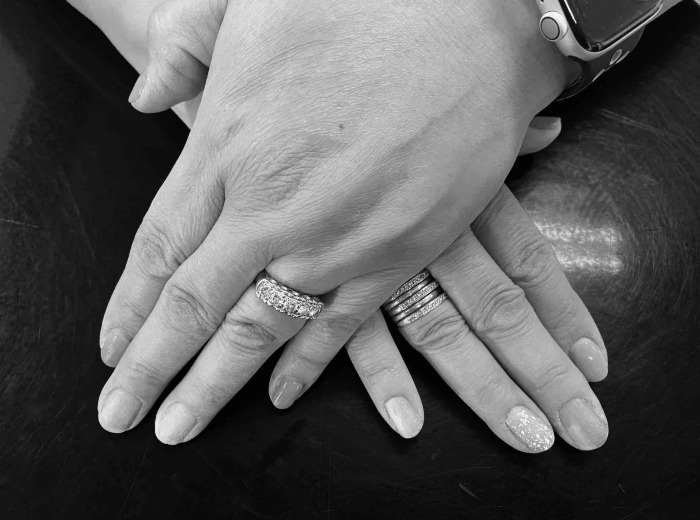Fingernail — Stuk
Stunka nauwakarluteng taaten. – My fingernails are growing too long.

Photo: Emily Capjohn's hands, AM888
All primates have nails, the hard plate-like covering found at the ends of fingers and toes. Human nails correspond to the claws found in animals, and like claws, they are made of a tough protein called keratin. The Alutiiq word stuk means both fingernail and toenail. Speakers also use this term for a hoof or a claw. Children were scared into good behavior with stories of a scary claw. Parents warned that if you played with your dolls before the end of Lent, a stuk or claw, would come out of the bed and get you!
Fingernails are tools. Alutiiq people used their fingernails for many simple tasks, like flicking fly eggs off drying salmon filets and making fibers for weaving and sewing. Seamstresses separated thin lengths of animal tendon into thread with their nails and weavers used their nails to split spruce roots to create long, even strips of weaving material.
Fingernails also have spiritual significance. Elders also recall that some people collected their fingernail and hair clippings over their lifetimes so these pieces of their bodies could be buried with them at death. This practice follows Alutiiq beliefs about the power of human and animal bodies and the essence preserved in pieces of a living creature. For example, the hides of animals used in parkas were thought to transfer qualities of those animals to the parka’s wearer. Similarly, Alutiiq whalers harvested the fat from the corpses of influential dead people to mix into hunting poison. They harvested the power of ancestral hunters and leaders to make a physically and spiritually potent poison.
Fingernails are tools. Alutiiq people used their fingernails for many simple tasks, like flicking fly eggs off drying salmon filets and making fibers for weaving and sewing. Seamstresses separated thin lengths of animal tendon into thread with their nails and weavers used their nails to split spruce roots to create long, even strips of weaving material.
Fingernails also have spiritual significance. Elders also recall that some people collected their fingernail and hair clippings over their lifetimes so these pieces of their bodies could be buried with them at death. This practice follows Alutiiq beliefs about the power of human and animal bodies and the essence preserved in pieces of a living creature. For example, the hides of animals used in parkas were thought to transfer qualities of those animals to the parka’s wearer. Similarly, Alutiiq whalers harvested the fat from the corpses of influential dead people to mix into hunting poison. They harvested the power of ancestral hunters and leaders to make a physically and spiritually potent poison.
